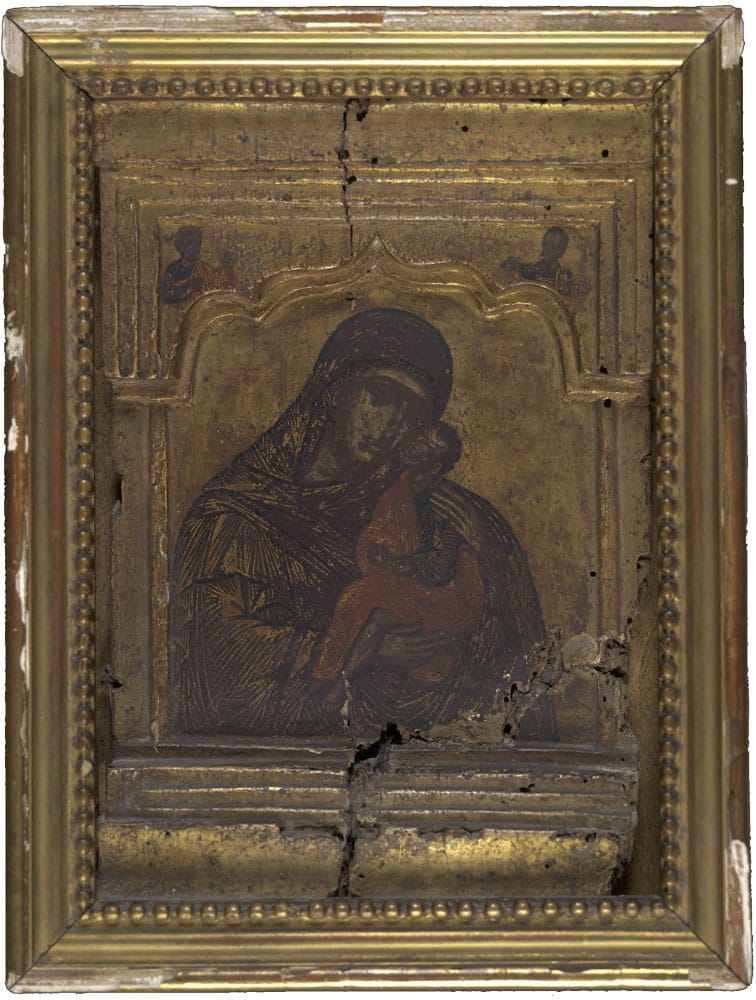The icon is painted in egg tempera with gold leaf on lime wood, primed with gesso over linen. The Virgin is depicted half length, turned three-quarters to the right and holding the Child with both hands. She inclines her head gently towards him thus enabling their cheeks to touch in an affectionate embrace. They are both dressed in garments decorated with dense gold striations. The Virgin is wearing a dark blue kekryphalos (headscarf) over which is a russet maphorion (veil) covering her head and shoulders, while Christ is in a blue chiton (tunic) and red himation (cloak), leaving his left leg uncovered. Both the Virgin and Child have haloes, which are distinguished from the gold background with double incised concentric circles. In the upper corners of the raised frame are the bust images of St Peter on the left and St Paul on the right, turning towards each other.
The panel’s shape and the hinge marks on its lateral edges indicate that it used to be the central part of a triptych. The reverse is covered with priming, which is rather worn, while the sides are painted red. The beaded frame is a later addition.
The representation of the Virgin on icons is often divided into a number of types, some of which are identified with specific titles in Byzantium. The type of the Virgin embracing Jesus and holding him to her cheek is sometimes in modern descriptions called ‘Eleousa’ (Tenderness) or if seen to be more intimate it may be called ‘Glykophilousa’ (Sweet Kissing), but only the former term is found inscribed on Byzantine icons. The latter appears only after the 15th century (Vassilaki and Tsironis 2000). Both terms might be used today to describe the type found on the BM icon, which has no inscription apart from ‘Mother of God’. This emotional imagery, representing the Virgin with a serious and sad expression, belongs to a group of images of the Virgin and Child that prefigure the passion of Christ. For instance, his bare leg has been interpreted as alluding to his naked body in scenes of the Entombment (Baltoyanni 1994, 17–21). The BM icon with the Child holding a scroll and with his leg uncovered follows an iconography that was used by 15th-century Cretan painters (Vassilaki 2010) and which became widespread in the Orthodox world (Baltoyanni 1994, 22–31, nos 1–10). Among the best known examples of this type are an early 15th-century icon from the Church of the Prophet Elijah in the Chora of Naxos attributed to the painter Angelos Akotantos (see Vassilaki 2010), as well as another icon of roughly the same period, formerly in a private collection in Rome but now at the Cleveland Museum of Art, which is ascribed to either Andreas Ritzos (Baltoyanni 1994, 24, no. 2, pl. 2) or Angelos (http://www.clevelandart. org/art/ 2010.154).
Even though the BM icon uses this Cretan formula, its style does not connect with Crete. Instead it shares features found in icons from northern Greece such as the 17th-century reliquary depicting the Synaxis (‘gathering’) of healing saints including Ermolaos and Panteleimon from the Pantokrator Monastery, Mount Athos (Kalamartzi-Katsarou 1998). The modelling of the flesh with dark brown under-paint and expanses of ochre, the rendering of the eyes with a simple black and white dot (only visible on the images of the apostles) as well as the prominent black outlines of the figures suggest a 17th-century painter from northern Greece. The drawing is somewhat weak, as in Christ’s hands holding the scroll.
The elaborate shape and carving of the raised frame with the characteristic wavy and sharply pointed arch also suggest an attribution to the north of Greece. Since such icons are found on Mount Athos, it might have been produced there. Parallels are to be found on a number of portable triptychs associated with the monastic community of Athos and dated to the 16th–17th centuries. For instance, on the BM triptych of the Dormition of the Virgin, a panel representing the Deisis from the Monastery of St Paul, Mount Athos (Vassilaki 1999), or that of the same subject and saints from the Rena Andreadis collection (Drandaki 2002).
Literature: A. Karakatsani, Εικόνες συλλογής Γεωργίου Τσακύρογλου, Athens, 1980, 71–2, 92, no. 83; C. Baltoyanni, Icons. The Mother of God in the Incarnation and the Passion, Athens, 1994; K. Kalamartzi-Katsarou, ‘Icons 16th-18th Century’, in S. Papadopoulos and C. Kapioldassi-Soteropoulou (eds), Icons of the Holy Monastery of Pantokrator, Mount Athos, 1998, 211, 213, fig. 111; M. Vassilaki, ‘Icons of the 17th Century’, in M. Vassilaki, I. Tavlakis and E. Tsigaridas (eds), The Holy Monastery of Aghiou Pavlou. The Icons, Mount Athos, 1999, 97–139, esp. 111, fig. 48; M. Vassilaki and N. Tsironis, ‘Representations of the Virgin and their Association with the Passion of Christ’, in M. Vassilaki (ed.), Mother of God. Representations of the Virgin in Byzantine Art (exh. cat., The Benaki Museum), Milan, 2000, 454–5, 461, n. 14, 17, 18; A. Drandaki, Greek Icons. 14th–18th century. The Rena Andreadis Collection, Athens, 2002, 230–1, no. 56; R. Cormack, Icons, London, 2007 (repr. 2014), 120, no. 32; M. Vassilaki (ed.), The Hand of Angelos: An Icon Painter in Venetian Crete (exh. cat., The Benaki Museum), Athens, 2010, 189, no. 43.
Eleni Dimitriadou
